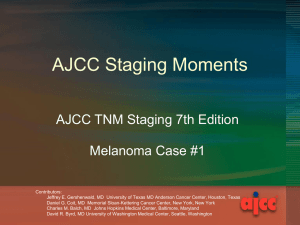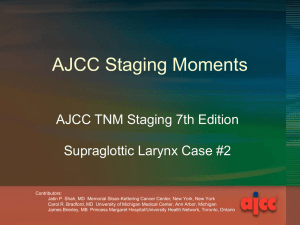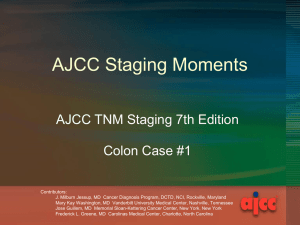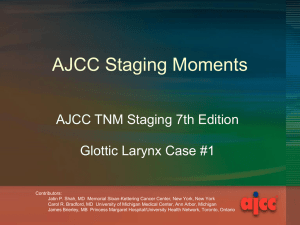Staging Moments Melanoma Case 3
advertisement
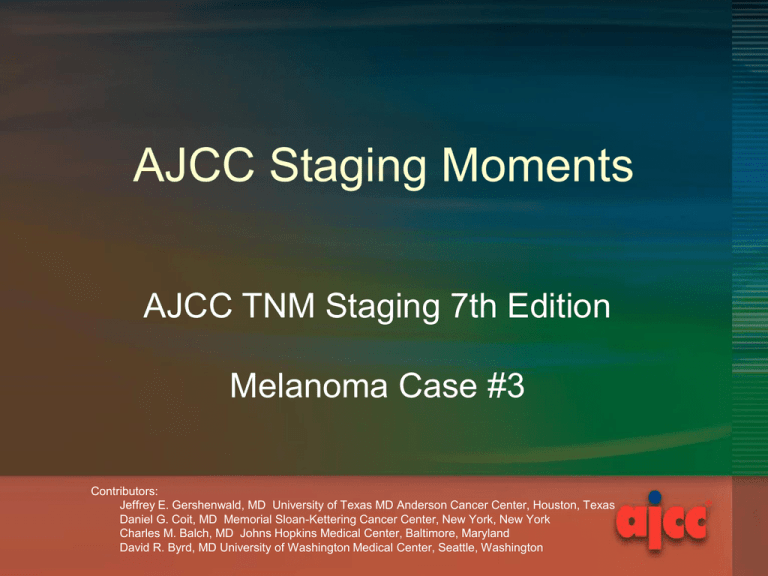
AJCC Staging Moments AJCC TNM Staging 7th Edition Melanoma Case #3 Contributors: Jeffrey E. Gershenwald, MD University of Texas MD Anderson Cancer Center, Houston, Texas Daniel G. Coit, MD Memorial Sloan-Kettering Cancer Center, New York, New York Charles M. Balch, MD Johns Hopkins Medical Center, Baltimore, Maryland David R. Byrd, MD University of Washington Medical Center, Seattle, Washington Melanoma Case # 3 Presentation of New Case • Newly diagnosed melanoma patient • Presentation at Cancer Conference for treatment recommendations and clinical staging Melanoma Case # 3 History & Physical • 79 yr old male who presented with a pigmented skin lesion left mid back, lesion enlarging and changing color, no lymphadenopathy • No family hx Used with permission. Halpern A, Charles C, Marghoob A. Atlas of Cancer. Edited by Maurie Markman, Ashfaq A. Marghoob. ©2002 Current Medicine Inc. Melanoma Case # 3 Imaging Results • No imaging Melanoma Case # 3 Diagnostic Procedure • Procedure – Incisional skin bx left mid thoracic back • Pathology Report – – – – – – Melanoma Breslow tumor thickness 0.8mm Ulceration present Mitoses 1/mm2 Clark’s level II Margins involved Melanoma Case # 3 Clinical Staging • Clinical staging – Uses information from the physical exam, imaging, and diagnostic biopsy • Purpose – Select appropriate treatment – Estimate prognosis Melanoma Case # 3 Clinical Staging • Synopsis- elderly patient with 0.8mm in tumor thickness melanoma skin left mid back with ulceration present, mitosis 1/mm2, clinically negative nodes • What is the clinical stage? – – – – T____ N____ M____ Stage Group______ Melanoma Case # 3 Clinical Staging • Clinical Stage correct answer – – – – T1b N0 M0 Stage Group IB • Based on stage, treatment is selected • Review NCCN treatment guidelines for this stage Melanoma Case # 3 Clinical Staging • Rationale for staging choices – T1b for <1.0mm in thickness, mitosis 1/mm2, and ulceration present – N0 because nodes were clinically negative on imaging * – M0 because there was nothing to suggest distant metastases * * if there was, appropriate tests would be performed before developing a treatment plan Prognostic Factors Clinically Significant • Applicable to this case – Measured tumor thickness: 0.8mm – Ulceration: present – Mitotic Rate: 1/mm2 Melanoma Case # 3 Surgery & Findings • Procedure – Wide excision – 2 cm margin – Sentinel node procedure • Operative findings – Sentinel nodes identified by dye and radioactive tracer Melanoma Case # 3 Pathology Results • • • • • • • Melanoma Superficial spreading and desmoplastic type Breslow tumor thickness 6.0mm Ulceration present Mitosis 1/mm2 Margins negative 1/4 left axillary nodes positive for melanoma Melanoma Case # 3 Pathologic Staging • Pathologic staging – Uses information from the clinical staging supplemented or modified by information from surgery and the pathology report • Purpose – Additional precise data for estimating prognosis – Calculating end results (survival data) Melanoma Case # 3 Pathologic Staging • Synopsis- patient with 6mm in thickness melanoma, ulceration present, mitoses 1/mm2, mets in 1 clinically negative regional node • What is the pathologic stage? (remember, clinical M may be used in pathologic staging) – – – – T____ N____ M____ Stage Group______ Melanoma Case # 3 Pathologic Staging • Pathologic Stage correct answer – – – – pT4b pN1a cM0 Stage Group IIIB • Based on pathologic stage, there is more information to estimate prognosis and adjuvant treatment is selected Melanoma Case # 3 Pathologic Staging • Rationale for staging choices – pT4b is >4mm in thickness, with ulceration present – pN1a because one clinically negative axillary node was positive – cM0 – use clinical M with pathologic staging unless there is pathologic confirmation of distant metastases Prognostic Factors Clinically Significant • Applicable to this case – Measured thickness: 6.0mm – Ulceration: present – Mitotic Rate: 1/mm2 AJCC Cancer Staging Atlas T4b is >4.0mm in thickness, with ulceration N1a is clinically occult (microscopic) mets Melanoma Case # 3 Recap of Staging • Summary of correct answers – Clinical stage T1b N0 M0 Stage Group IB – Pathologic stage T4b N1a cM0 Stage Group IIIB • The staging classifications have a different purpose and therefore can be different. Do not go back and change the clinical staging based on pathologic staging information. Staging Moments Summary • Review site-specific information if needed • Clinical Staging – Based on information before treatment – Used to select treatment options • Pathologic Staging – Based on clinical data PLUS surgery and pathology report information – Used to evaluate end-results (survival)


